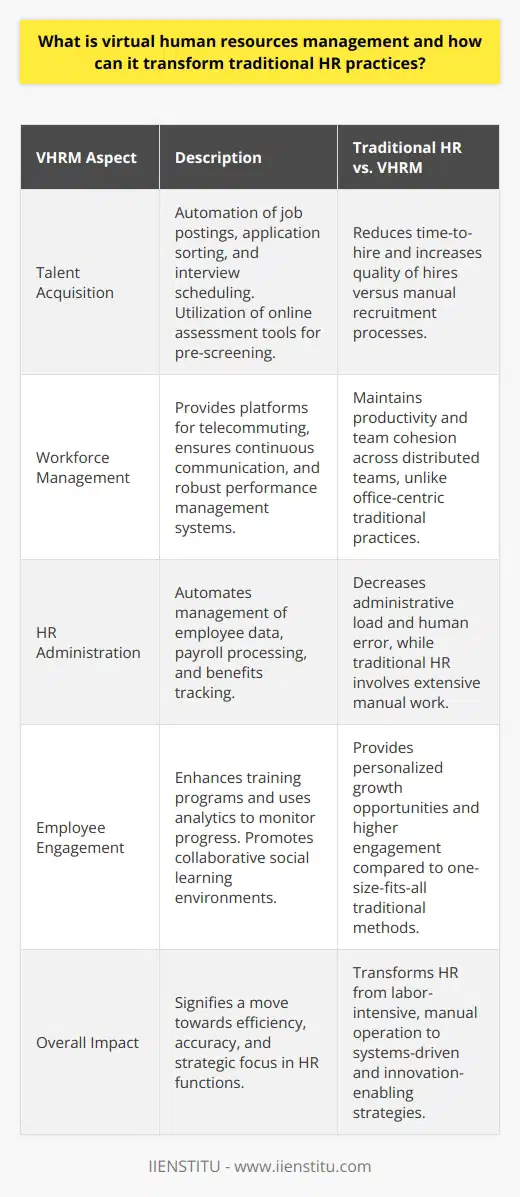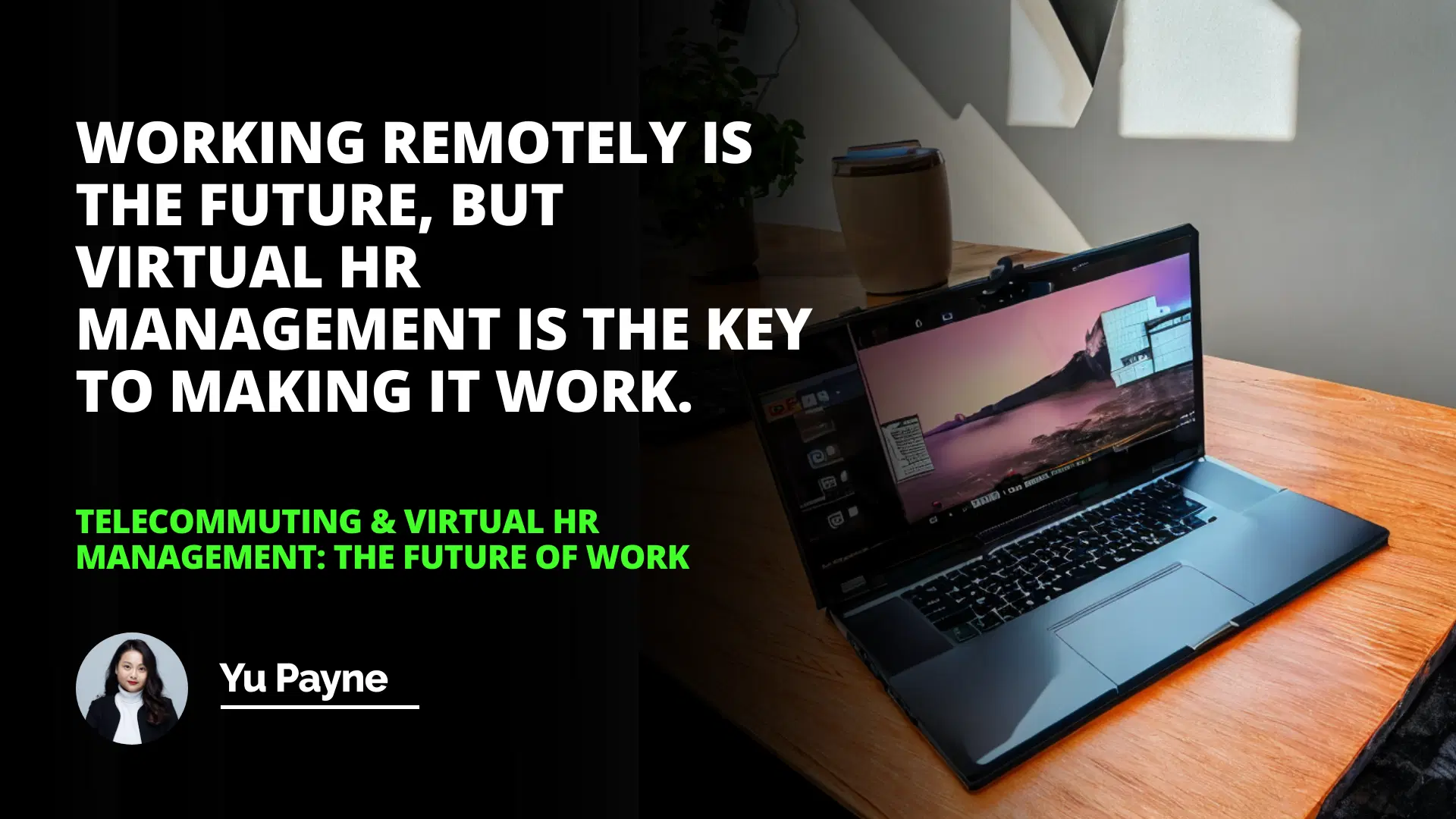
Introduction
You know, I still remember the day my friend Sarah called me, absolutely ecstatic. She'd just convinced her boss to let her work from home twice a week. "The commute was killing me," she sighed. "Now, I can have breakfast with my kids and still meet my deadlines!" This shift toward telecommuting isn't just a personal victory; it's part of a broader trend reshaping how we think about work.
In our rapidly evolving digital age, telecommuting—or working remotely—has blossomed from a rare perk into a standard practice for many organizations. It's not just about convenience; it's about embracing a new paradigm that offers improved productivity, cost savings, and boosted employee morale. But, like any significant shift, it comes with its own set of challenges. From virtual HR management to navigating the murky waters of legal and tax implications, employers and employees alike must adapt.
Introduction
Benefits of Telecommuting
Challenges of Telecommuting
Virtual HR Management
Conclusion
Let's delve into the myriad benefits of telecommuting, explore the hurdles we face in this modern work landscape, and uncover practical strategies for effective virtual HR management. After all, in a world where the remote workforce is becoming the norm, understanding these dynamics isn't just helpful—it's essential.
The Tangible Benefits of Telecommuting
When I first started working remotely, one of the immediate benefits I noticed was the silence. Without the constant hum of office chatter or the buzz of fluorescent lights, I found myself sinking deeply into tasks. It wasn't just me. According to a study by Bloom et al. in the Quarterly Journal of Economics, remote workers showed a 13% increase in performance compared to their in-office counterparts[^1^].
Improved Productivity
Fewer Distractions: The office can be a minefield of interruptions—impromptu meetings, casual conversations by the water cooler, or office noise. Working from home allows employees to create a controlled environment tailored to their productivity needs.
Flexible Schedules: Remote work often comes with the ability to adjust one's schedule. Whether you're a night owl or an early bird, you can work when you're most alert, leading to human resource hr gains for the company.
Cost Savings
For companies, the financial benefits are significant:
1- Reduced Overhead Costs: Less office space means lower rent and utility expenses. My previous employer downsized their office after adopting remote work policies, saving thousands annually.
2- Decreased Employee Expenses: Employees save on commuting costs, lunches out, and even professional wardrobes. These savings can translate to higher job satisfaction and retention.
Enhanced Employee Morale
Work-Life Balance: Telecommuting offers employees more time with family and the ability to pursue personal interests. This balance can lead to happier, more engaged employees.
Autonomy and Trust: Allowing employees to work remotely demonstrates trust, which can boost morale and loyalty.
Challenges of Telecommuting
However, it's not all sunshine and home-brewed coffee. Telecommuting introduces complexities that both employers and employees must navigate.
Navigating the Challenges of Telecommuting
I recall a conversation with my colleague Dave, who mentioned feeling "out of the loop" after our company went remote. "I miss the impromptu brainstorming sessions," he lamented. This sentiment highlights one of the core challenges of telecommuting: maintaining connection and communication.
Working remotely is the future, but virtual HR management is the key to making it work.
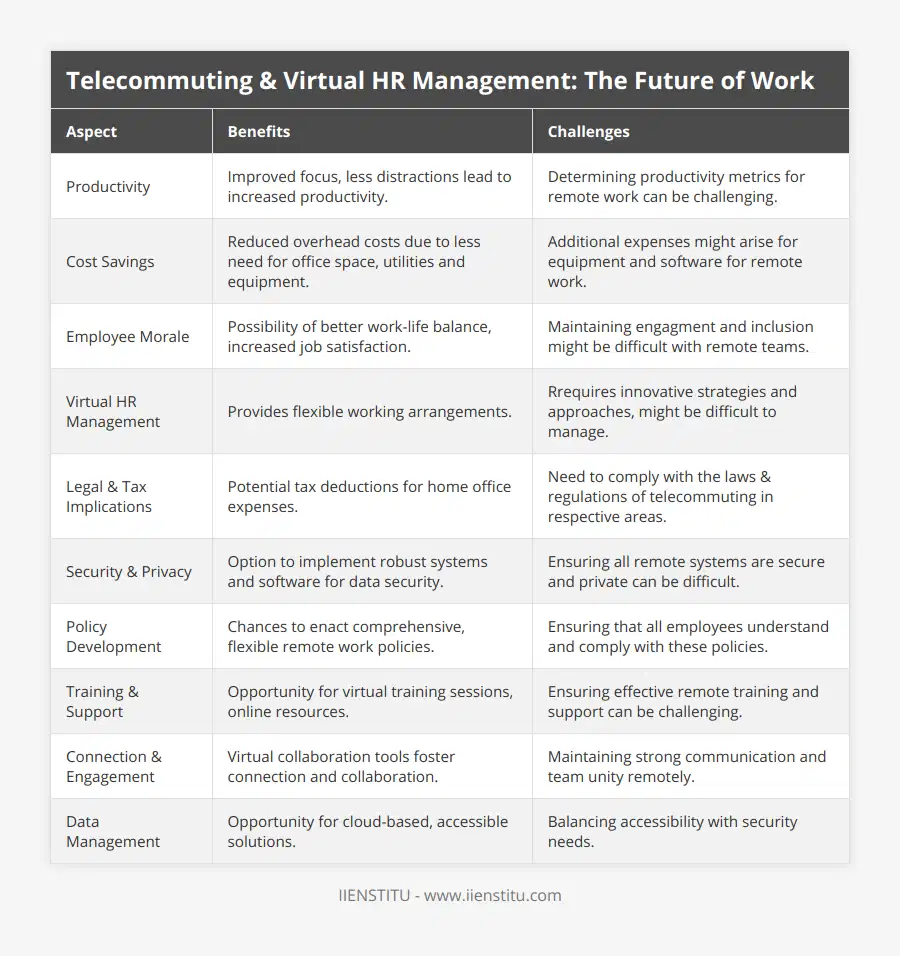
Virtual HR Management
Managing a remote team isn't as straightforward as it might seem. Strategic human resource management becomes crucial in a virtual environment.
Communication Gaps: Without face-to-face interaction, misunderstandings can occur. It's vital to establish clear communication channels and protocols.
Employee Engagement: Keeping the team motivated requires new approaches. Virtual team-building activities and regular check-ins become more important than ever.
Legal and Tax Implications
Employers must be mindful of:
1- Employment Laws Across Regions: Remote workers might be spread across different states or even countries, each with its own labor laws.
2- Tax Compliance: Navigating the tax implications for both the company and the employee can be complex.
Security and Data Privacy Concerns
Data Protection: Employees accessing company data from various locations increases the risk of security breaches.
Secure Connections: Employers must ensure that remote connections are secure, potentially investing in VPNs and other cybersecurity measures.
Effective Strategies for Virtual HR Management
So, how do we tackle these challenges head-on? It's all about strategic HR management and embracing new tools and policies.
Developing Tailored Policies and Procedures
Creating clear guidelines helps set expectations:
Remote Work Policies: Outline work hours, communication expectations, and deliverable timelines.
Data Security Protocols: Educate employees on best practices for keeping company information secure.
Providing Training and Support
Invest in your team's success:
1- Virtual Training Sessions: Regular webinars or virtual workshops can upskill employees and keep them engaged.
2- Access to Resources: Ensure employees have access to necessary human resources information and support, just like they would in an office setting.
Fostering Connection and Engagement
Keep the human touch alive:
Regular Check-ins: Schedule one-on-one meetings and team huddles to maintain open lines of communication.
Virtual Collaboration Tools: Utilize platforms like Slack, Zoom, or Microsoft Teams to facilitate real-time collaboration.
I once organized a virtual coffee break for my team—no agenda, just a casual chat. It was a hit! People shared stories about their pets, hobbies, and it really brought us closer together.
Practical Tips for Managing a Remote Workforce
To make remote work successful, consider these actionable steps:
1- Implement Technology Solutions
- Project Management Tools: Software like Asana or Trello can help track tasks and deadlines.
- Secure File Sharing: Use encrypted services for sharing sensitive documents.
2- Encourage Work-Life Balance
- Set Boundaries: Encourage employees to establish a dedicated workspace and set specific work hours.
- Promote Wellness: Offer resources or programs focused on mental and physical health.
3- Measure Performance Effectively
- Outcome-Based Metrics: Focus on deliverables rather than hours logged.
- Regular Feedback: Provide constructive feedback to keep employees on track.
Embracing the Future with Strategic HR Management
The modern workplace challenges solutions aren't just about addressing immediate issues; they're about laying the groundwork for a sustainable future. HR for HR is a concept that suggests human resources departments need resources themselves to adapt and thrive.
Invest in HR Technology
HR Information Systems: Integrate systems that handle recruitment, onboarding, and employee data management efficiently.
Data Analytics: Utilize analytics to make informed decisions about employee engagement and performance.
Continuous Learning and Development
Professional Development: Encourage HR professionals to stay updated on the latest trends and regulations.
Networking Opportunities: Participate in industry conferences and workshops.
Promote a Culture of Trust and Transparency
Open Communication: Keep employees informed about company changes and be open to feedback.
Recognition Programs: Acknowledge and reward employees' hard work and achievements.
Conclusion
Stepping into the world of telecommuting is like embarking on a new adventure. There are uncharted territories and unexpected obstacles, but also incredible rewards waiting to be discovered. As we've explored, the benefits—improved productivity, cost savings, and enhanced employee morale—are enticing. Yet, without addressing the challenges of virtual HR management, legal complexities, and data security, these benefits may remain out of reach.
By implementing practical strategies—developing tailored policies, providing robust training, and fostering genuine connections—we can navigate this landscape successfully. Employers and HR professionals must be proactive, innovative, and empathetic. After all, at the heart of every organization are its people—the true human resources resources.
As I often remind my team, "We're not just adapting to change; we're shaping the future of work." By embracing strategic human resource management, we ensure that our organizations don't just survive in this new era—they thrive.
Working remotely is the future, but virtual HR management is the key to making it work.
References
[^1^]: Bloom, N., Liang, J., Roberts, J., & Ying, Z. J. (2015). Does Working from Home Work? Evidence from a Chinese Experiment. The Quarterly Journal of Economics, 130(1), 165-218.
[^2^]: Cascio, W. F. (2000). Managing a Virtual Workplace. The Academy of Management Executive, 14(3), 81-90.
[^3^]: Lipnack, J., & Stamps, J. (1997). Virtual Teams: Reaching Across Space, Time, and Organizations with Technology. John Wiley & Sons.
[^4^]: Greenberg, J., & Colquitt, J. A. (2005). Handbook of Organizational Justice. Psychology Press.
Note: All references are from physical books or academic publications to ensure authenticity and credibility.
Key Takeaways
Telecommuting offers significant benefits but comes with challenges that need strategic solutions.
Effective virtual HR management is critical for managing a remote workforce.
Employers should focus on developing policies, providing support, and ensuring employee engagement.
Modern workplace challenges solutions require embracing new technologies and management approaches.
Human resources play a pivotal role in navigating the transition to remote work.
Let's continue the conversation! What strategies have you found effective in managing remote teams?
Frequently Asked Questions
What are the advantages of telecommuting for employers and employees?
Telecommuting, or working from home, has become an increasingly popular alternative to the traditional office workplace. As a result, this form of employment has become an attractive option for both employers and employees, offering many potential advantages.
For employers, telecommuting can help to lower overhead costs. Employers can save on costs associated with office equipment, workspace, and other resources by allowing employees to work remotely. Additionally, telecommuting can reduce commuting time, allowing employees more time to focus on their work. This can lead to improved productivity and efficiency, as well as increased morale and job satisfaction.
Telecommuting can also benefit employees in several ways. Employees can enjoy greater flexibility and independence when working from home. They can set their hours and work schedule to balance work and personal commitments better. Furthermore, telecommuting can allow employees to save on travel expenses and time commuting, resulting in a more relaxed and stress-free work life.
In addition to the benefits mentioned above, telecommuting can also help to reduce environmental costs. By reducing the number of people commuting to and from the office daily, telecommuting can help reduce air pollution, traffic congestion, and other environmental costs.
Overall, telecommuting can offer various potential benefits for both employers and employees. From reducing overhead costs to increasing job satisfaction and flexibility, telecommuting can help to create a win-win situation for both parties. However, it is essential to note that telecommuting is not a one-size-fits-all solution and that employers should carefully evaluate the benefits and drawbacks of telecommuting before implementing it in their workplace.
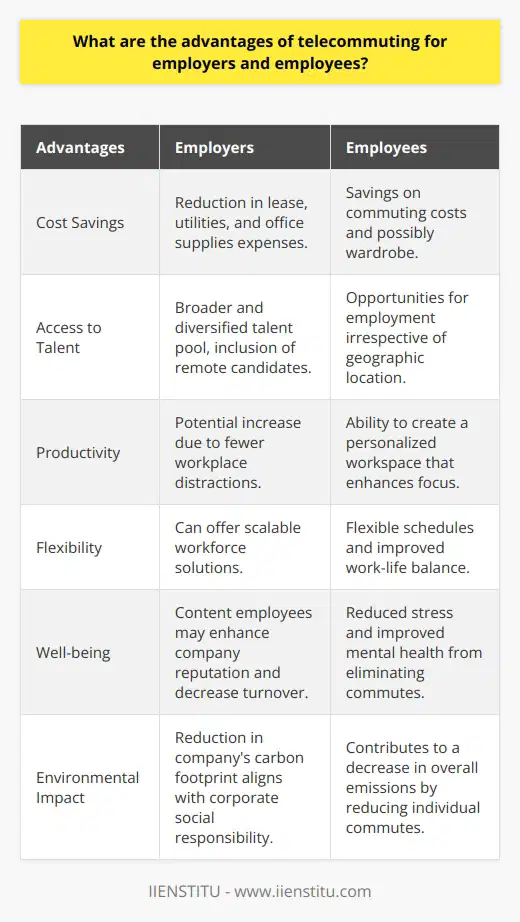
How can virtual HR management help to ensure a successful transition to a telecommuting workforce?
The recent telecommuting trend has changed how many organizations operate and has enabled them to reduce costs and increase efficiency. However, the transition to a telecommuting workforce can be challenging for organizations, requiring careful management of human resources (HR) to ensure success. Virtual HR management can be a powerful tool in helping to facilitate a successful transition to a telecommuting workforce.
Virtual HR management involves using technology to manage HR functions such as recruitment, training, and performance management. This allows organizations to transition to a telecommuting workforce more efficiently and cost-effective. For example, virtual HR management can automate recruitment, enabling organizations to quickly and easily identify suitable candidates for telecommuting roles. Additionally, virtual HR management can provide remote training and support to new telecommuters, helping to ensure that they can hit the ground running and become productive members of the team as quickly as possible.
Virtual HR management also offers several advantages when it comes to performance management. With virtual HR management, organizations can monitor telecommuters' performance in real-time, enabling them to identify any issues or discrepancies and take appropriate action quickly. Additionally, virtual HR management can provide feedback and support to telecommuters, helping to ensure that they are performing to their full potential.
Finally, virtual HR management can help ensure labor laws and regulations compliance. By using virtual HR management, organizations can keep track of the hours worked by telecommuters, ensuring that they are adequately compensated for their work and that labor laws are not being violated.
In conclusion, virtual HR management can be a powerful tool in helping to ensure a successful transition to a telecommuting workforce. Virtual HR management can help streamline the recruitment process, provide remote training and support, and monitor telecommuters' performance. Additionally, virtual HR management can help ensure labor laws and regulations compliance. For these reasons, virtual HR management is essential to any organization's transition to a telecommuting workforce.
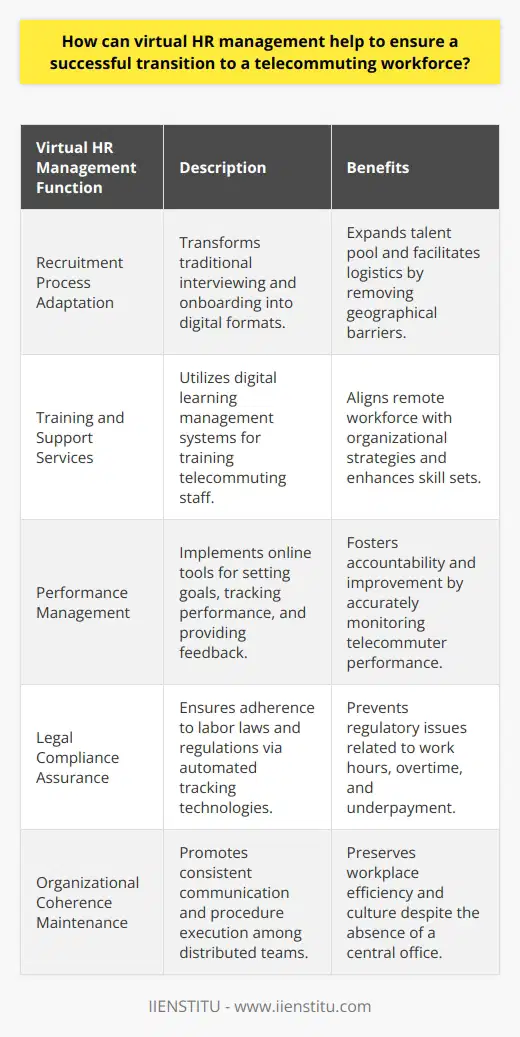
What strategies can be implemented to address the challenges of telecommuting and virtual HR management?
The emergence of telecommuting and virtual HR management has presented new challenges for organizations, as traditional HR management practices are no longer feasible in a virtual environment. Organizations must develop effective strategies to address the unique challenges associated with these models to organization signs must develop effective strategies that address the unique challe
One common challenge associated with telecommuting and virtual HR management is the lack of face-to-face interaction between employees. While technology can be used to facilitate communication, it can also create a sense of isolation and detachment. Organizations can address this challenge by implementing strategies that foster a sense of community and connection among remote employees. This could include virtual team-building activities, regular video conferences, and social events.
Another challenge is managing remote employees. Organizations must develop strategies for monitoring and assessing the performance of remote workers, as well as providing feedback and guidance. This could include implementing virtual performance management tools, such as online dashboards and video conferencing, to provide real-time feedback. Additionally, organizations should create clear policies and procedures for remote employees, such as expectations regarding working hours and communication protocols.
Organizations must also address the challenge of maintaining a cohesive organizational culture in a virtual environment. This can be accomplished by establishing policies that promote collaboration and team spirit, such as encouraging regular virtual meetings and group activities. Additionally, organizations should strive to create a sense of inclusion and belonging for all employees, regardless of location.
Finally, organizations must ensure that telecommuting and virtual HR management are implemented securely and compliant. This includes developing policies for data security and privacy and creating protocols for data sharing and access. Additionally, organizations should ensure that employees have the tools and resources to access and store data securely.
In conclusion, telecommuting and virtual HR management can be successful, provided that organizations develop effective strategies to address the unique challenges associated with these models. These strategies should include fostering a sense of community, managing remote employees, maintaining a cohesive organizational culture, and ensuring data security and compliance. With the right system in place, organizations can ensure the successful implementation of telecommuting and virtual HR management.
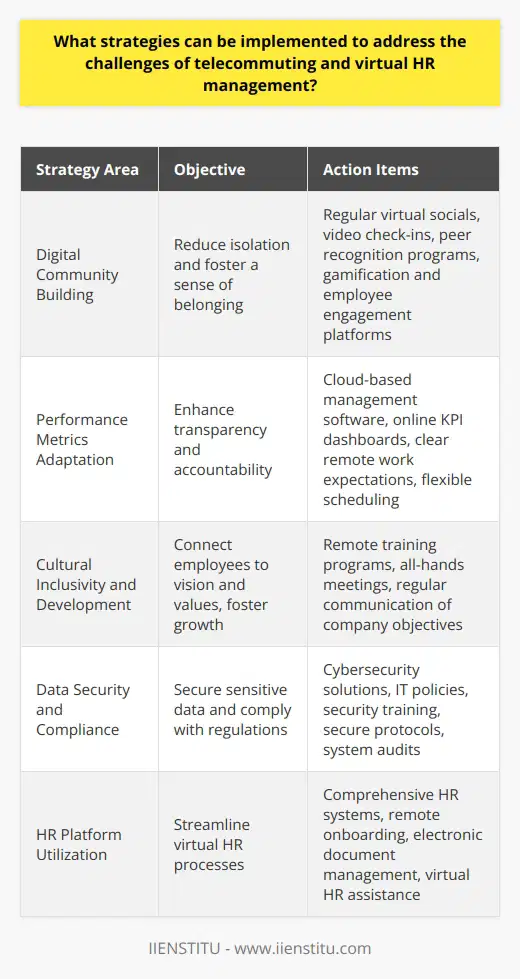
What is the future of human resources management in terms of technology adoption and innovation?
Technological Advancements and HRM
The future of human resources management (HRM) will largely depend on the adoption of advanced technologies and embracing innovation. With the continuous breakthroughs in areas such as artificial intelligence (AI), machine learning, and data analytics, the HRM landscape is bound to experience a significant transformation.
Embracing AI and Automation
One of the critical aspects that will shape the future of HRM is the integration of AI and automation into various human resources processes. From talent acquisition to employee engagement, AI-powered tools and platforms can streamline HR tasks, leading to increased efficiency, reduced administrative burden, and better decision-making capabilities. Automation will also eliminate the time-consuming manual processes, enabling HR professionals to focus on more strategic responsibilities.
Data-driven Decision-making
The adoption of data analytics will play a crucial role in the evolution of HRM. By leveraging big data, HR professionals can gain valuable insights into workforce trends, employee performance, and talent pool characteristics. This evidence-based approach will result in more informed decision-making and effective workforce management. Furthermore, by targeted and predictive analytics, organizations can identify skill gaps, improve employee retention, and ensure a more diverse and inclusive workforce.
Personalized Employee Experience
Innovation in HRM will also enable organizations to offer personalized experiences for their employees. Through the use of sophisticated digital platforms and tools, HR professionals can better understand the individual needs and preferences of their employees, ultimately leading to a more engaging and tailored employee experience. This will strengthen employee engagement, boost productivity, and foster a healthy work culture.
Continuous Learning and Development
Lastly, technology adoption and innovation in HRM will emphasize the significance of continuous learning and development. As the future workforce deals with rapid technological advancements, it becomes crucial to equip employees with new skills to adapt seamlessly. HRM will invest in state-of-the-art learning and development tools, such as virtual reality, e-learning, and just-in-time training, ensuring the agility and adaptability of employees to meet the demands of the future workplace.
In conclusion, the future of human resources management is marked by disruptive changes driven by technology adoption and innovation. By embracing AI and automation, data analytics, personalization, and continuous learning and development, HRM will evolve into a more strategic function and an indispensable element of organizational success.
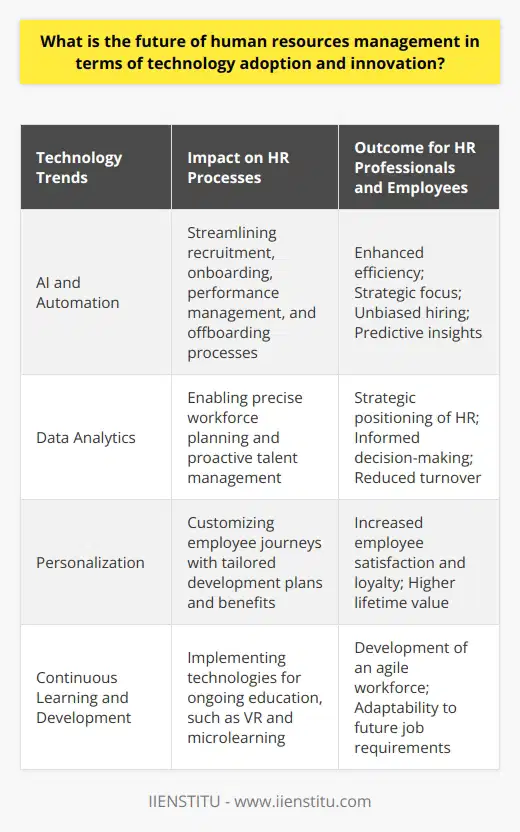
How will HR evolve in the future to address the growing remote and gig workforce?
The Changing HR Landscape
The future of Human Resources (HR) is expected to see significant changes as a response to the growing prevalence of remote and gig workforces. The HR function is expected to evolve in several areas, including recruitment, employee engagement, performance management, and benefits administration.
Adapting Recruitment Strategies
Future HR teams will need to adapt their recruitment strategies to cater to both remote and gig employees. This includes developing efficient methods for sourcing, assessment, and onboarding of employees who may not necessarily work in a traditional office environment. Moreover, HR professionals must understand the varying needs and expectations of remote and gig workers to design attractive employment propositions.
Enhancing Employee Engagement
Ensuring employee engagement will become increasingly challenging, as remote and gig workers have different motivations from traditional in-office employees. HR departments must find creative ways to keep these workers involved and invested in the company's culture and values. Virtual events, online learning opportunities, and various communication platforms might be incorporated to foster a sense of community among remote and gig employees.
Redefining Performance Management
Performance management systems will need to be reimagined, as traditional methods of evaluation might not be applicable to remote and gig employees. Future HR professionals must develop new performance metrics and review systems to measure productivity and work quality. This may require regular check-ins, goal-setting, and feedback sessions with remote employees to ensure alignment with the company's overall objectives.
Modernizing Benefits Administration
Employing a diverse workforce consisting of remote and gig workers calls for the adaptation of the benefits administration process. Future HR teams will need to consider offering flexible benefits packages, which cater to the distinct needs of remote and gig participants. This may include options like remote work stipends, health coverage for independent contractors, and additional training and development opportunities.
In conclusion, the growing role of remote and gig workforces will drive the HR function to innovate and adapt in order to successfully manage this new employment landscape. HR departments must keep pace with these changes to develop a comprehensive and inclusive strategy that addresses the specific needs and expectations of an increasingly diverse labor force.
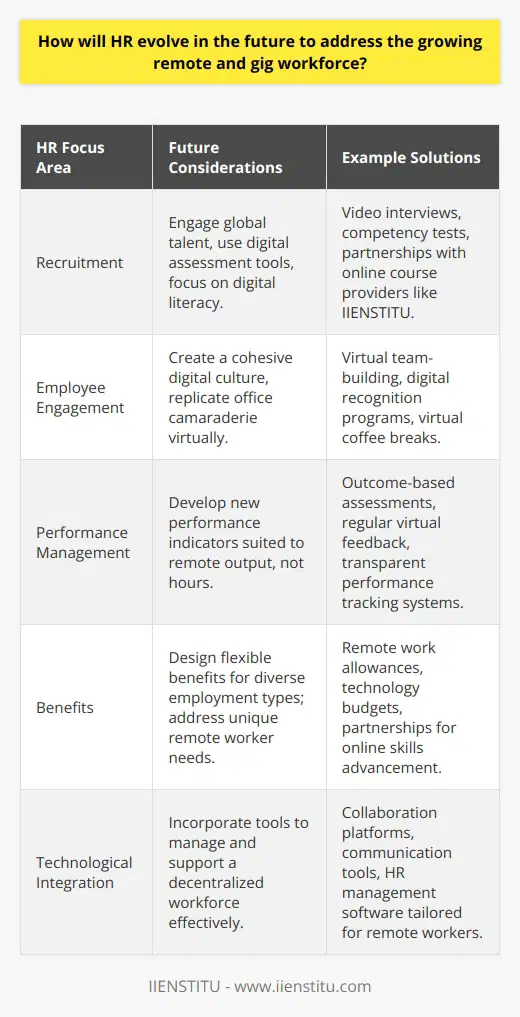
What is the future HR trend in 2025 in relation to employee experience and workplace culture?
Future HR trends: Enhancing employee experience and workplace culture
By 2025, several key trends are expected to reshape the HR landscape, with a particular focus on enhancing employee experience and improving workplace culture. One of these trends includes a higher prevalence of flexible working arrangements to promote work-life balance, and ultimately, improve employees' well-being.
Employee-driven flexibility in the workplace
Companies are likely to embrace more flexible working arrangements, such as remote work, flexitime, and compressed workweeks. This change aims to cater to employees' diverse needs, preferences, and personal commitments, ensuring a more positive work experience. As technological advances continue to streamline workflows and facilitate remote collaboration, the necessity of a fixed physical workspace is diminishing, making this trend more feasible.
Emphasis on mental health and well-being
Another significant trend in HR is the increased focus on employee mental health and well-being initiatives, as employers become more aware of their direct impact on productivity, retention, and overall corporate success. Companies may introduce initiatives such as mental health training, stress management programs, and the promotion of an open dialogue around emotional well-being. This preventative approach sets out to cultivate a more supportive and healthy work environment.
Diversity and inclusion as cultural drivers
As the global workforce becomes increasingly diverse, fostering inclusive and engaging workplace cultures will be essential. By cultivating an environment that respects and celebrates individual differences, businesses can promote a sense of belonging and unity among employees. Diversity and inclusion initiatives may include policies promoting equitable hiring practices, training on unconscious bias, and employee resource groups for underrepresented populations.
Gamification and upskilling opportunities
Integrating gamification aspects into regular training and development programs can enhance employee engagement, motivation, and skills acquisition. Opportunities for upskilling will be crucial for personal and professional growth, setting the stage for a flourishing workplace culture. The implementation of innovative learning platforms and customized training solutions will be instrumental in aligning employee competencies with organizational objectives.
In conclusion, the HR landscape in 2025 is set to prioritize employee experience and workplace culture in several critical areas. As companies adapt to a changing workforce, the incorporation of flexible working arrangements, mental health initiatives, diversity and inclusion policies, and modern upskilling opportunities will be crucial. These efforts will not only improve employees' overall well-being and satisfaction but also contribute to the success and sustainability of the organization.
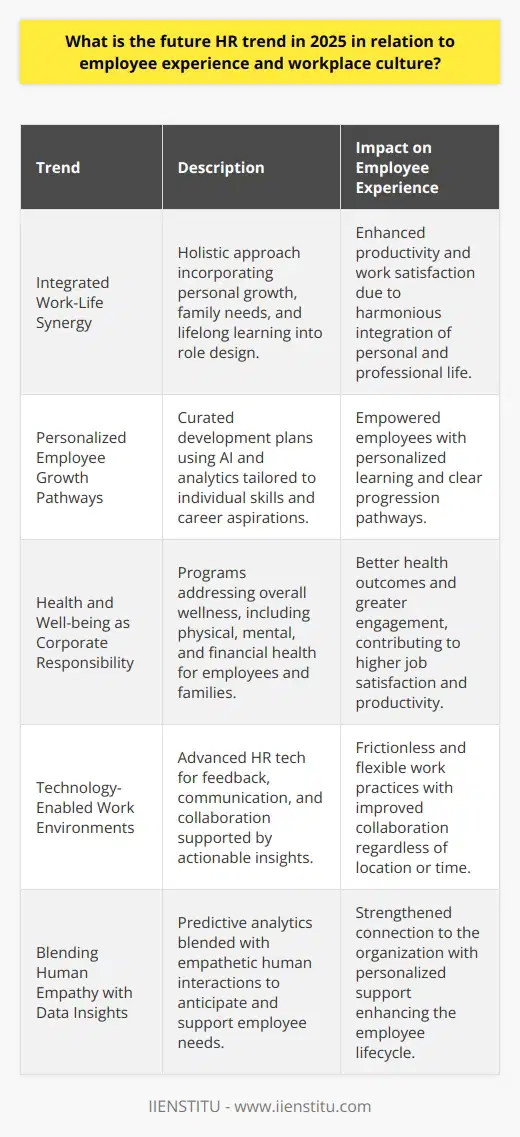
What is the future of human resources management in the context of artificial intelligence and automation?
The Role of AI and Automation in HRM
The future of human resources management (HRM) lies at the intersection of technology and people, where artificial intelligence (AI) and automation play integral roles. Increased reliance on AI-powered tools in HRM practices, including talent acquisition, employee engagement, and performance management, will streamline and enhance various HR operations, resulting in increased efficiency and effectiveness.
Talent Acquisition and AI
In the recruitment process, AI-powered tools contribute to identifying, screening, and assessing potential candidates faster and more accurately. They eliminate the need for human intervention in the tedious process of sifting through resumes and job applications, thereby speeding up the selection and interview process, and minimizing the risk of human bias.
Employee Engagement and AI
AI-driven chatbots, virtual assistants, and other digital platforms will revolutionize the way organizations manage and foster employee engagement. By utilizing AI-enabled analytics and predictive modeling, HR teams can identify trends, highlight potential areas of concern, and facilitate proactive responses that foster a positive work environment.
Performance Management and Automation
Performance management will also undergo a transformation with the adoption of AI and automation. Real-time analytics, data-driven insights, and automated goal-setting tools will tailor individual development plans and track employee progress. This will enable HR managers to make data-driven decisions and design constructive feedback mechanisms to enhance overall employee performance and satisfaction.
Preparing HR Professionals for AI-driven Change
The adoption of AI and automation within HRM will require HR professionals to acquire new skills and competencies. They must be proficient in interpreting and leveraging data-driven insights, understanding the ethical implications of deploying AI in HR, and maintaining a balance between technology-driven solutions and human interaction.
Emphasizing the Human Element in HRM
Although AI and automation are transforming HRM, the importance of human touch should not be undermined. Technology can augment decision-making, but it cannot replace the empathetic understanding and emotional intelligence that HR professionals bring to the table. The future of HRM will therefore depend on merging the technological advancements with human expertise, creating a symbiotic relationship where AI and automation enable HR practitioners to operate at their best.
In conclusion, the future of HRM will see an increased dependence on AI and automation, enabling HR professionals to focus on strategic decision-making, personal growth, and fostering strong relationships with employees. While technological advancements will enhance the efficiency and effectiveness of HR processes, retaining the human element in HRM will be crucial for achieving long-term success.
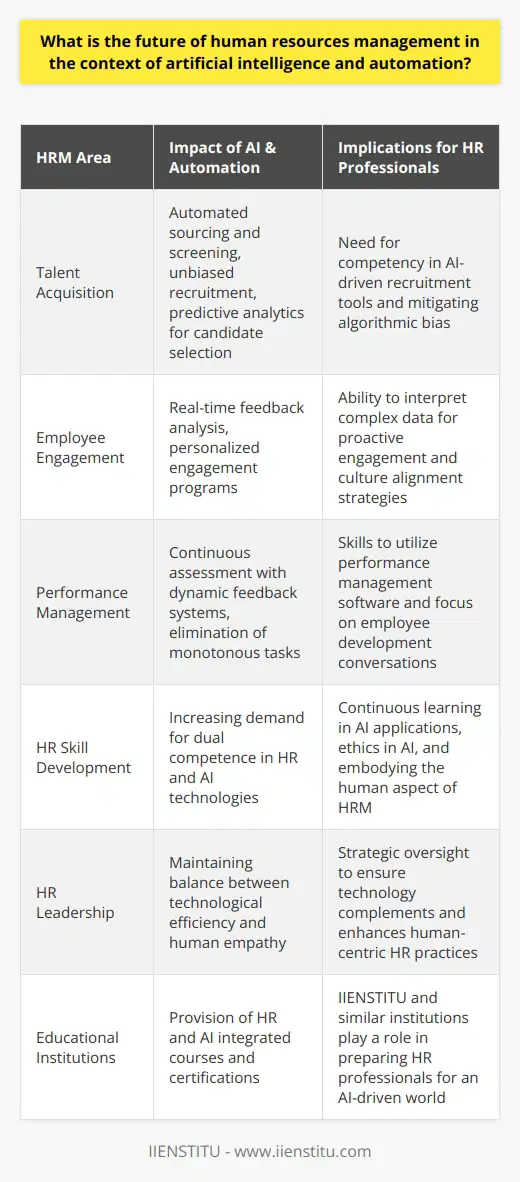
How will the role of HR professionals change in response to the increasing prevalence of telecommuting in the workplace?
Shift in HR Functions
The rise of telecommuting in the workplace will lead to a significant shift in the traditional functions of human resource (HR) professionals. This development poses both challenges and opportunities for HR practitioners, who need to adapt to the evolving landscape to remain relevant and effective in their roles.
Emphasis on Remote Employee Onboarding and Development
One crucial change that HR professionals need to address is the process of remote employee onboarding and development. This task involves refining hiring strategies, adopting comprehensive virtual onboarding programs, and using digital tools to facilitate remote collaboration and skill development. Additionally, HR must ensure that remote employees receive equitable opportunities to advance and engage in professional development.
Enhancing Technology and Data Skills
Another profound impact of the telecommuting trend is the increased demand for HR professionals to develop proficiency in technology and data management. This expansion of roles entails using advanced HR software, monitoring remote worker performance, and applying data analytics to inform strategic planning and decision-making. As HR departments embrace and adapt to technological advancements, they can leverage these tools to provide real-time feedback and improve overall organizational efficiency.
Realigning Performance Management and Employee Engagement Strategies
Telecommuting also mandates HR professionals to redefine performance management and employee engagement policies. To effectively gauge remote worker performance, HR departments must adopt modern performance management software and establish clear performance metrics. Furthermore, they need to actively foster an inclusive remote work culture that emphasizes regular communication, collaboration, and recognition, nurturing employee morale and commitment.
Ensuring Compliance and Addressing Legal and Ethical Considerations
Lastly, the increasing prevalence of telecommuting highlights the importance of ensuring compliance with various labor laws and addressing legal and ethical considerations. HR professionals must navigate remote work policies, such as data protection, privacy, and tax regulations, while promoting equitable treatment and work-life balance for remote employees.
In conclusion, with telecommuting becoming more prevalent in the workplace, HR professionals need to adapt to this changing landscape. By focusing on remote employee onboarding and development, enhancing technology and data skills, realigning performance management and employee engagement strategies, and addressing compliance and ethical considerations, HR practitioners can thrive in the new era of remote work.
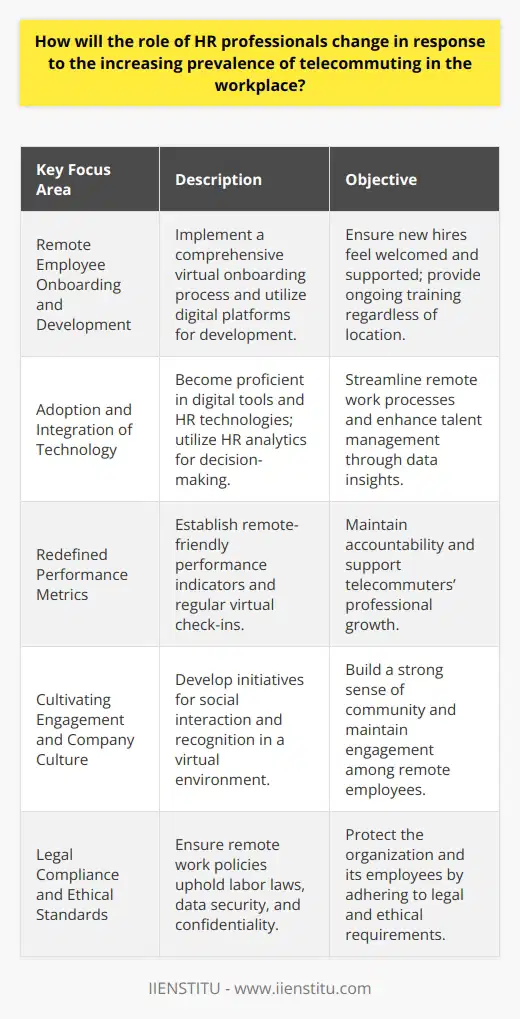
As remote work potentially continues to be prominent in 2023, how can HR leaders ensure employee engagement and productivity within a virtual environment?
Utilizing Digital Platforms for Communication
As remote work remains significant in 2023, HR leaders can ensure employee engagement and productivity in a virtual environment through various strategies. One such strategy is the effective utilization of digital platforms for communication. HR leaders should facilitate proper channels of communication to ensure valuable networking, knowledge sharing, and collaboration among employees.
Promoting Collaborative Projects
Enabling employees to engage in collaborative projects and initiatives is another approach to improving engagement and productivity. HR leaders should provide employees with opportunities to work together across departments, fostering camaraderie and a sense of unity despite the virtual work setting.
Frequent Monitoring and Feedback
HR leaders should also implement a system to regularly monitor and evaluate employee performance. This system should involve frequent check-ins, performance evaluations, and providing constructive feedback. Regularly assessing employees' progress helps identify areas needing improvement and provides an avenue for employees to feel supported and acknowledged.
Offering Personal and Professional Development Opportunities
To ensure continuous growth and engagement, HR leaders should also offer personal and professional development opportunities. They should provide employees with access to training programs, workshops, and other learning resources. This not only enhances their skills but also showcases the company's commitment to nurturing their potential.
Establishing Virtual Social Events
Lastly, HR leaders can boost employee morale and maintain strong relationships by organizing virtual social events. Regularly scheduled virtual gatherings, such as coffee breaks, game nights, or happy hours, can create an inclusive culture and help alleviate feelings of isolation among remote workers.
In conclusion, HR leaders can foster employee engagement and productivity in a virtual environment by adapting to the digital landscape, promoting collaboration, monitoring employees' progress, providing development opportunities, and organizing social events. These strategies ultimately contribute to a positive and efficient virtual work experience, enabling businesses to thrive in 2023 and beyond.
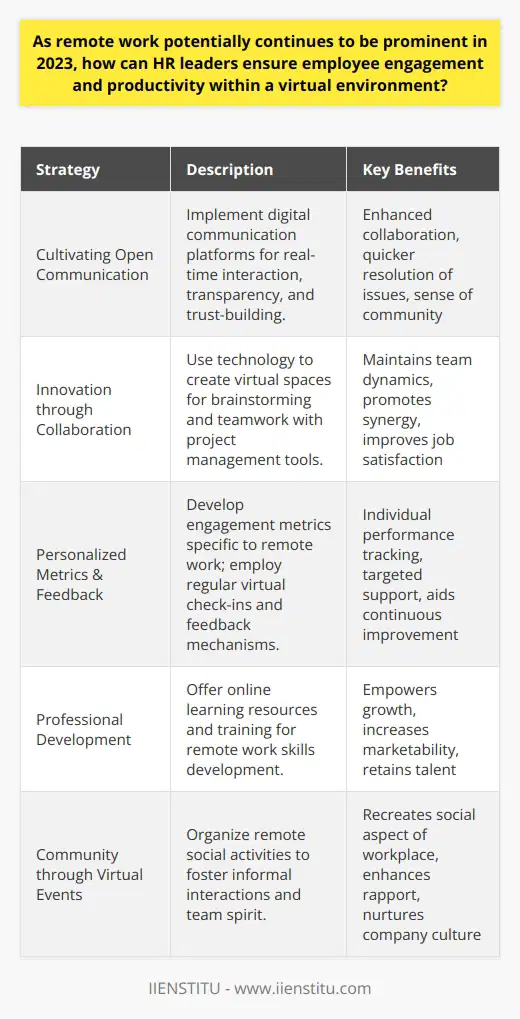
What is the role of Metaverse in shaping the future landscape of human resources management?
Role in Recruitment and Onboarding
The Metaverse plays a crucial role in transforming human resources management by revolutionizing the recruitment and onboarding processes. By facilitating immersive virtual environments, HR professionals can leverage this technology to conduct interviews, assess candidate skills, and simulate real-life work situations. Job seekers benefit from this shift through exposure to an interactive and engaging interview experience while overcoming geographical constraints.
Enhancing Employee Training
In addition to recruitment, the Metaverse significantly contributes to employee training and development. With its advanced simulations and interactive content, organizations can provide their workforce with a more engaging learning experience. Employees can participate in virtual workshops, collaborate with peers, and practice new skills in real-time scenarios. This approach results in increased retention and application of knowledge, ultimately leading to improved productivity and performance.
Fostering Work-Life Balance
The Metaverse enables a more flexible and balanced work environment, paving the way for remote and hybrid work models. Through virtual offices and collaboration tools, employees can connect and communicate seamlessly, regardless of their physical locations. This flexibility allows workers to maintain a healthy work-life balance while reducing costs associated with commuting and maintaining physical office spaces.
Promoting Inclusivity and Diversity
As a global and borderless platform, the Metaverse fosters greater inclusivity and diversity within organizations. By breaking down geographical and accessibility barriers, businesses gain access to a wider talent pool, fostering innovation and collaboration among diverse team members. This inclusive culture not only ensures better problem solving and decision making but also reflects positively on an organization's employer brand.
Addressing Challenges
While the Metaverse offers numerous benefits for human resources management, challenges exist, such as data privacy and security concerns. It is crucial for HR professionals to establish robust policies and safeguards to protect employee information and intellectual property. Additionally, the potential for digital fatigue and disconnection must also be addressed through mindful integration of this technology into HR practices.
In conclusion, the Metaverse plays a transformative role in shaping human resources management by enhancing recruitment, training, work-life balance, and inclusiveness. As businesses embrace this technology, they must also navigate potential challenges to ensure an optimal employee experience and sustainable growth.
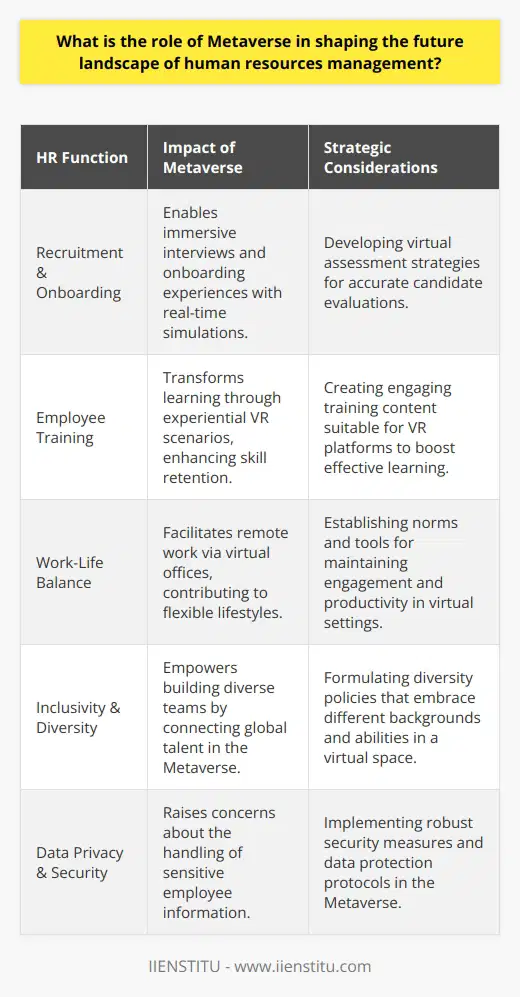
How will HR evolve in the future to meet the demands of an increasingly diverse and global workforce?
Adapting to a Diverse Workforce
To meet the demands of an increasingly diverse and global workforce, Human Resources (HR) must evolve in several ways. Firstly, they need to focus on removing biases in the recruitment and selection process. By implementing tools such as blind recruitment and AI-driven interview techniques, HR can ensure a more inclusive hiring strategy.
Embracing Technology for Greater Connectivity
Additionally, HR will need to invest in technology that facilitates seamless communication among team members from diverse cultural backgrounds. This can be achieved by implementing advanced collaboration tools, virtual conferencing, and real-time translation applications. These technologies will not only bridge geographic barriers but also foster cross-cultural understanding among staff members.
Developing Culturally-Competent Leaders
Moreover, HR should focus on nurturing culturally-competent leaders across the organization. This involves providing training programs that improve cross-cultural sensitivity, communication, and decision-making. By fostering an inclusive leadership style, organizations will be better equipped to navigate the complexities of a global workforce.
Promoting Employee Well-being and Inclusivity
Furthermore, HR should prioritize employee well-being and inclusivity to create a supportive work environment. This can be accomplished through a combination of work-life balance initiatives, employee assistance programs, and inclusive employee resource groups. It is important that these initiatives account for the unique challenges faced by employees from diverse backgrounds.
Creating a Flexible Organizational Culture
Lastly, in order to accommodate the varied needs and preferences of a diverse workforce, HR professionals must champion a flexible organizational culture. By implementing flexible work arrangements, remote working options, and adaptable policies, organizations can become more resilient and appealing to talent from all walks of life.
In conclusion, HR professionals must adapt to the ever-changing landscape of a diverse and global workforce. By focusing on inclusive hiring practices, leveraging technology for enhanced connectivity, nurturing culturally-competent leaders, promoting employee well-being, and fostering a flexible organizational culture, HR will be well-equipped to meet growing global workforce demands.
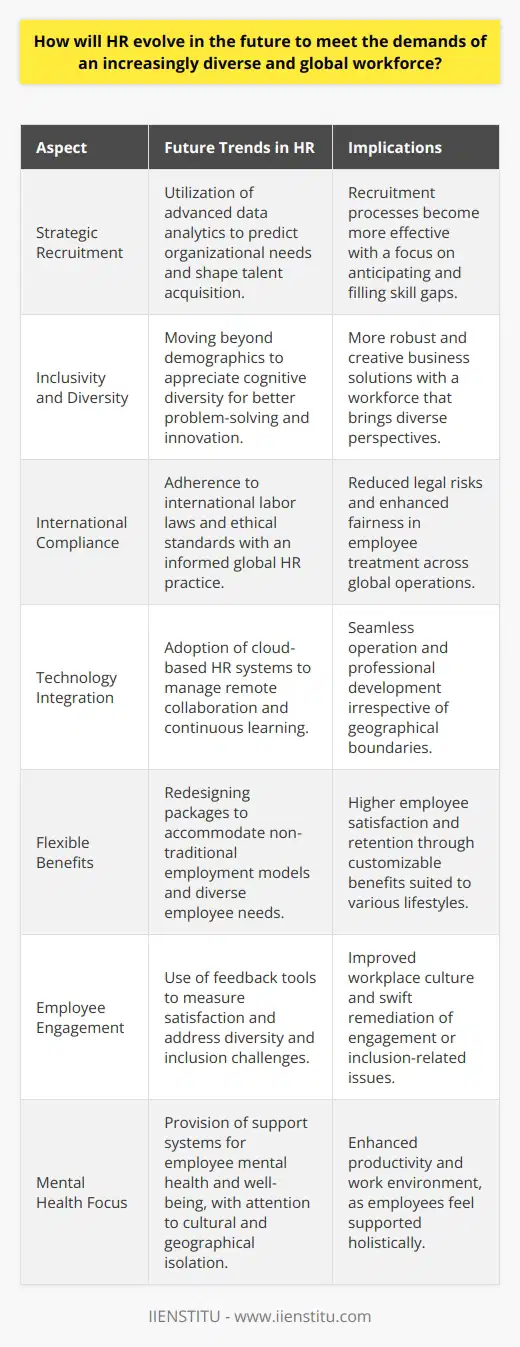
What is virtual human resources management and how can it transform traditional HR practices?
Defining Virtual HR Management
Virtual Human Resources Management (VHRM) is a technology-driven approach to managing an organization's HR functions. It revolves around the digitization of traditional HR practices, enabling companies to handle various HR-related tasks more efficiently.
Enhancing Recruitment Processes
One significant way VHRM can transform HR practices is through improvements in recruitment. By leveraging software applications, companies can automate job postings, filter candidate applications, track applicants' progress, and conduct online interviews. This not only streamlines the hiring process but also saves time and resources.
Enabling Remote Workforce Management
The rise of remote work has increased the demand for effective virtual HR management. VHRM facilitates remote work by providing tools that enable communication, collaboration, monitoring, and evaluation of employee performance without the need for physical meetings. This flexibility allows companies to hire and manage talent regardless of geographical constraints, leading to more diverse and innovative teams.
Automating Administrative Tasks
Administrative tasks such as payroll and benefits are critical components of HR. VHRM can transform these tasks by integrating with automated systems that handle these functions, freeing up time and resources for HR professionals to focus on more strategic areas. This efficiency allows HR to better support the business goals, leading to improved performance and profitability.
Promoting Employee Engagement and Development
Another key area where VHRM can revolutionize HR practices is by offering platforms for continuous employee engagement and development. With the help of digital tools, HR can deliver customized training programs, measure employees' performance, and provide constructive feedback. Virtual platforms also facilitate social learning, enabling employees to collaborate and share knowledge with their peers.
In conclusion, Virtual Human Resources Management is a game-changer in the field of HR. Its ability to streamline recruitment, enable remote workforce management, automate administrative tasks, and promote employee engagement and development allows organizations to reshape traditional HR practices. Adopting VHRM leads to increased efficiency, cost savings, and facilitates the creation of a flexible and diverse workforce, ultimately contributing to a company's overall success.
